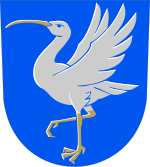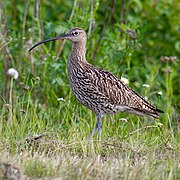Curlew
| Curlew | |
|---|---|

| |
| Long-billed curlew (Numenius americanus) Fishing Pier, Goose Island State Park, Texas | |
| Scientific classification | |
| Domain: | Eukaryota |
| Kingdom: | Animalia |
| Phylum: | Chordata |
| Class: | Aves |
| Order: | Charadriiformes |
| Family: | Scolopacidae |
| Genus: | Numenius Brisson, 1760 |
| Type species | |
| Scolopax arquata Linnaeus, 1758
| |
| Species | |
|
N. phaeopus | |
| Synonyms | |
|
Palnumenius Miller, 1942 | |
The curlews (/ˈkɜːrljuː/) are a group of nine species of birds in the genus Numenius, characterised by their long, slender, downcurved bills and mottled brown plumage. The English name is imitative of the Eurasian curlew's call, but may have been influenced by the Old French corliu, "messenger", from courir , "to run". It was first recorded in 1377 in Langland's Piers Plowman "Fissch to lyue in þe flode..Þe corlue by kynde of þe eyre".[1] In Europe, "curlew" usually refers to one species, the Eurasian curlew (Numenius arquata).
Description
[edit]They are one of the most ancient lineages of scolopacid waders, together with the godwits which look similar but have straight bills.[2] Curlews feed on mud or very soft ground,[3][4] searching for worms and other invertebrates with their long bills. They will also take crabs and similar items.
Distribution
[edit]
Curlews enjoy a worldwide distribution. Most species exhibit strong migratory habits and consequently one or more species can be encountered at different times of the year in Europe, Ireland, Britain, Iberia, Iceland, Africa, Southeast Asia, Siberia, North America, South America and Australasia.
The distribution of curlews has altered considerably in the past hundred years as a result of changing agricultural practices. For instance, Eurasian curlew populations have suffered due to draining of marshes for farmland, whereas long-billed curlews have shown an increase in breeding densities around areas grazed by livestock.[5][6] As of 2019[update], there were only a small number of Eurasian curlews still breeding in Ireland, raising concerns that the bird will become extinct in that country.[7]
The stone-curlews are not true curlews (family Scolopacidae) but members of the family Burhinidae, which is in the same order Charadriiformes, but only distantly related within that.
Taxonomy
[edit]The genus Numenius was erected by the French scientist Mathurin Jacques Brisson in his Ornithologie published in 1760.[8] The type species is the Eurasian curlew (Numenius arquata).[9] The Swedish naturalist Carl Linnaeus had introduced the genus Numenius in the 6th edition of his Systema Naturae published in 1748,[10] but Linnaeus dropped the genus in the important tenth edition of 1758 and put the curlews together with the woodcocks in the genus Scolopax.[11][12] As the publication date of Linnaeus's sixth edition was before the 1758 starting point of the International Commission on Zoological Nomenclature, Brisson and not Linnaeus is considered as the authority for the genus.[13] The name Numenius is from Ancient Greek noumenios, a bird mentioned by Hesychius. It is associated with the curlews because it appears to be derived from neos, "new" and mene "moon", referring to the crescent-shaped bill.[14]
The genus contains nine species:[15]
| Common name | Scientific name and subspecies | Range | Size and ecology | IUCN status and estimated population |
|---|---|---|---|---|
| Eurasian whimbrel | Numenius phaeopus (Linnaeus, 1758) Five subspecies
|
subarctic Asia and Europe as far south as Scotland
|
Size: Habitat: Diet: |
LC
|
| Hudsonian whimbrel | Numenius hudsonicus Latham, 1790 |
southern North America and South America. It
|
Size: Habitat: Diet: |
LC
|
| Slender-billed curlew †? (Last seen in 1995 [16])
|
Numenius tenuirostris Vieillot, 1817 |
Russia, Persian gulf, in Kuwait and Iraq.
|
Size: Habitat: Diet: |
CR
|
| Eurasian curlew | Numenius arquata (Linnaeus, 1758) |
temperate Europe and Asia
|
Size: Habitat: Diet: |
NT
|
| Long-billed curlew | Numenius americanus Bechstein, 1812 |
central and western North America
|
Size: Habitat: Diet: |
LC
|
| Far Eastern curlew | Numenius madagascariensis (Linnaeus, 1766) |
northeastern Asia, including Siberia to Kamchatka, and Mongolia. coastal Australia, with a few heading to South Korea, Thailand, Philippines and New Zealand | Size: Habitat: Diet: |
EN
|
| Little curlew | Numenius minutus Gould, 1841 |
Australasia, far north of Siberia. | Size: Habitat: Diet: |
LC
|
| Bristle-thighed curlew | Numenius tahitiensis (Gmelin, JF, 1789) |
tropical Oceania, and includes Micronesia, Fiji, Tuvalu, Tonga, Hawaiian Islands, Samoa, French Polynesia and Tongareva, lower Yukon River and Seward Peninsula
|
Size: Habitat: Diet: |
NT
|
| Eskimo curlew – †? (Last seen in 1987 [17])
|
Numenius borealis (Forster, 1772) |
western Arctic Canada and Alaska, Pampas of Argentina
|
Size: Habitat: Diet: |
CR
|
The following cladogram shows the genetic relationships between the species. It is based on a study published in 2023.[18]
| Numenius |
| ||||||||||||||||||||||||||||||||||||||||||||||||
The Late Eocene (Montmartre Formation, some 35 mya) fossil Limosa gypsorum of France was originally placed in Numenius and may in fact belong there.[19] Apart from that, a Late Pleistocene curlew from San Josecito Cave, Mexico has been described.[20] This fossil was initially placed in a distinct genus, Palnumenius, but was actually a chronospecies or paleosubspecies related to the long-billed curlew.
The upland sandpiper (Bartramia longicauda) is an odd bird which is the closest relative of the curlews.[2] It is distinguished from them by its yellow legs, long tail, and shorter, less curved bill.
References
[edit]- ^ "Curlew". Oxford English Dictionary (Online ed.). Oxford University Press. (Subscription or participating institution membership required.)
- ^ a b Thomas, Gavin H.; Wills, Matthew A.; Székely, Tamás (2004). "A supertree approach to shorebird phylogeny". BMC Evol. Biol. 4: 28. doi:10.1186/1471-2148-4-28. PMC 515296. PMID 15329156.
- ^ "How local farmers in Roscommon and their community got together to conserve a bog and protect rare birds". independent. Retrieved 2021-08-28.
- ^ "Reared curlews act like wild counterparts after release in Norfolk". BBC News. 2021-08-19. Retrieved 2021-08-28.
- ^ Encyclopedia of the Animal World (1977): Vol.6: 518–519. Bay Books, Sydney.
- ^ Cochrane, J. F.; Anderson, S. H. (1987). "Comparison of habitat attributes at sites of stable and declining Long-billed Curlew populations". Great Basin Naturalist. 47: 459–466.
- ^ Archived at Ghostarchive and the Wayback Machine: Christian TV Ireland (29 September 2019). Mary Colwell- Interview on the almost extinct Curlew bird in Ireland. Retrieved 29 September 2019 – via YouTube.
- ^ Brisson, Mathurin Jacques (1760). Ornithologie, ou, Méthode contenant la division des oiseaux en ordres, sections, genres, especes & leurs variétés (in French and Latin). Vol. 1. Paris: Jean-Baptiste Bauche. Vol. 1, p. 48, Vol. 5, p. 311.
- ^ Peters, James Lee, ed. (1934). Check-list of Birds of the World. Vol. 2. Cambridge, Massachusetts: Harvard University Press. p. 260.
- ^ Linnaeus, Carl (1748). Systema Naturae sistens regna tria naturæ, in classes et ordines, genera et species redacta tabulisque aeneis illustrata (in Latin) (6th ed.). Stockholmiae (Stockholm): Godofr, Kiesewetteri. pp. 16, 26.
- ^ Linnaeus, Carl (1758). Systema Naturæ per regna tria naturae, secundum classes, ordines, genera, species, cum characteribus, differentiis, synonymis, locis (in Latin). Vol. 1 (10th ed.). Holmiae (Stockholm): Laurentii Salvii. p. 145.
- ^ Allen, J.A. (1910). "Collation of Brisson's genera of birds with those of Linnaeus". Bulletin of the American Museum of Natural History. 28: 317–335. hdl:2246/678.
- ^ "Article 3". International Code of Zoological Nomenclature (4th ed.). London: International Trust for Zoological Nomenclature. 1999. ISBN 978-0-85301-006-7.
- ^ Jobling, James A (2010). The Helm Dictionary of Scientific Bird Names. London: Christopher Helm. p. 276. ISBN 978-1-4081-2501-4.
- ^ Gill, Frank; Donsker, David, eds. (2019). "Sandpipers, snipes, coursers". World Bird List Version 9.2. International Ornithologists' Union. Retrieved 26 June 2019.
- ^ "Magornitho".
- ^ "great Alaska department of fish and game".
- ^ Tan, H.Z.; Jansen, J.J.; Allport, G.A.; Garg, K.M.; Chattopadhyay, B.; Irestedt, M.; Pang, S.E.; Chilton, G.; Gwee, C.Y.; Rheindt, F.E. (2023). "Megafaunal extinctions, not climate change, may explain Holocene genetic diversity declines in Numenius shorebirds". eLife. 12: e85422. doi:10.7554/eLife.85422.
- ^ Olson, Storrs L. (1985): Section X.D.2.b. Scolopacidae. In: Farner, D.S.; King, J.R. & Parkes, Kenneth C. (eds.): Avian Biology 8: 174–175. Academic Press, New York.
- ^ Arroyo-Cabrales, Joaquín; Johnson, Eileen (2003). "Catálogo de los ejemplares tipo procedentes de la Cueva de San Josecito, Nuevo León, México" (PDF). Revista Mexicana de Ciencias Geológicas. 20 (1): 79–93. Archived from the original (PDF) on 2011-07-17. Retrieved 2007-04-29.
Further reading
[edit]- Bodsworth, Fred (1987). Last of the Curlews. Dodd, Mead. ISBN 0-396-09187-3. (originally published in 1954)
- Colwell, Mary (19 April 2018). Curlew Moon. William Collins. ISBN 978-0008241056. OCLC 1035290266.










